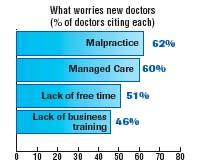Article
UPDATE: Focus on practice
Redesigned Maine Rx; new-doctor worries
UPDATE
Focus on Practice
By Joan R. Rose
Governor redesigns Maine Rx
Just 10 days after the US Supreme Court lifted an injunction against Maine's program to reduce prescription drug prices for residents, Gov. John F. Baldacci has shelved that plan and presented a redesigned program to the state legislature.
The new initiative, Maine Rx Plus, accommodates some of the Court's criticisms, but envisions even greater discounts. The state is developing a formulary of preferred drugs (with discounts ranging from 15 to 60 percent) for its health insurance program for low- and moderate-income residents, MaineCare. The Maine Rx Plus program will offer the same drugs and discounts as MaineCare to its participants, but the state hopes to negotiate additional rebates as well.
The redesign also addresses a concern raised by the Supreme Court: The original program was open to all residents without drug coverage, regardless of age or income. Participation now will be limited to those with incomes up to about $31,400 for individuals and $64,400 for a family of four.
The medmal crisis casts a shadow over the Sunshine State . . .
Blaming the state legislature's failure to enact meaningful tort reform, Florida Medical Association President Robert E. Cline closed his medical practice in late May for an "indefinite leave of absence." Cline, a thoracic surgeon in Broward County, warned that unless the legislature acts now to solve the liability crisis, many Florida patients will "permanently lose access to their physicians and to needed services."
A statewide poll conducted for the FMA found broad public support for tort reform, with four out of five respondents believing the legislature should hold a "special session" to reform the medical liability crisis.
. . . while more states face an OB crisis
Georgia, Ohio, Oregon, and Virginia have joined the American College of Obstetricians and Gynecologists' "red alert" list of crisis states where ob/gyns have problems obtaining or affording malpractice insurance. Eight states already on "red alert" are Florida, Mississippi, Nevada, New Jersey, New York, Pennsylvania, Texas, and Washington. ACOG also reports that a "crisis is brewing" in six others: Alabama, Connecticut, Illinois, Kentucky, Missouri, and Utah.
ACOG reports that ob/gyns are sued an average of 2.5 times over their career, and one in four is sued during residency. Among all specialties, according to the Physician Insurers Association of America, ob/gyns have the most number of paid claims and the highest total indemnity. The median award for medical liability in childbirth cases$2,050,000is the highest for all types of medical liability cases.
New doctors: Lots of jobs, but not satisfaction
The job market for new physicians has never been better, notes Joseph Hawkins, CEO of Merritt, Hawkins & Associates, a Dallas-based physician search firm. More than two-thirds of the residents surveyed this year had received 51 or more job solicitations, while 43 percent had received 100 or more.
Nevertheless, 24 percent say they'd choose a different field if they could begin again. That's the highest proportion the survey has found since it began in 1991.

Our Web Poll

Yvonne Wollenberg. UPDATE: Focus on practice.
Medical Economics
Jul. 11, 2003;80:22.





